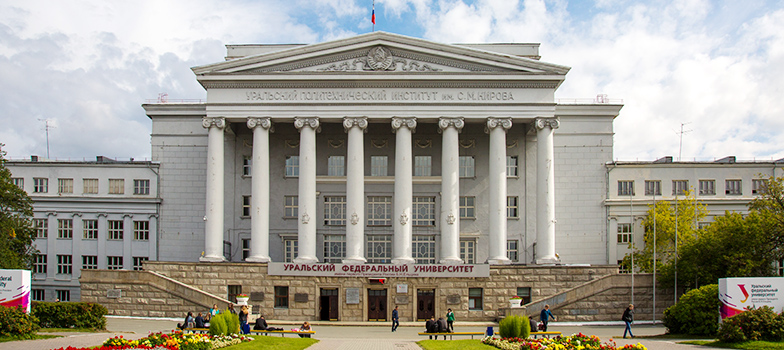Climate Can Change According to an Unexpected Scenario, Ural Federal University Physicists Say
Physicists have calculated in which case the “butterfly effect” will lead to climatic chaos
According to Dmitry Alexandrov, calculations have shown that random factors can lead to unpredictable consequences. Photo: Anna Marinovich.
Physicists of the Ural Federal University have calculated how the climate will change under the influence of random factors or noise (changes in various parameters). As a result, they received development scenarios that have no analogs. Scientists of UrFU and the Catholic University of Leuven (Leuven, Belgium) published models of scenarios in an article in one of the most authoritative physical journals – Physics Reports – with an impact factor of 25.809.
“Climate change is associated with many parameters – the rate of ice melting, desalination of the world’s oceans and changes in its temperature, the level of carbon dioxide and other gases in the atmosphere, and other parameters. The relationship between them determines the trajectory of climate dynamics. But it is impossible to calculate this trajectory, because the system is too complex. In addition, there are disturbances that take this system out of its normal state,” says Dmitri Alexandrov, Professor of the Department of Theoretical and Mathematical Physics at UrFU. – Our goal was to identify how strongly unpredictable factors affect the dynamics of the climate. And as calculations have shown, stochastic effects can change the climate in a completely unexpected way. Like the “butterfly effect”, when a small disturbance leads to unpredictable consequences.”
After studying deterministic matmodels with the original data, the scientists added a stochastic factor (criteria that do not take into account existing models) and showed that it is necessary for the climate to move from a warm state to a cold one (for example, two stable equilibria between which the system can switch). thus, two two-dimensional models explain the relationship between the average global temperature of the world’s oceans and the mass of sea ice and the relationship between temperature and vegetation. in the first case, random factors can create climate fluctuations and cause climate chaos. in the second case, noise with increasing intensity can lead to a gradual decrease in the average temperature and cause a catastrophic shift in the climate system to a state where the earth turns from a warm planet covered with vegetation into a snowball.
“We have identified the conditions under which the climate system can be brought out of equilibrium in the mode of oscillations with large differences in the temperature of the atmosphere and the area of glaciers. And for this it is not necessary to wait for a global catastrophe such as the fall of a large meteorite. The article describes situations when even small disturbances caused by seemingly insignificant factors – for example, cloud density-can make the behavior of the climate system unpredictable, that is, chaotic, “explains Lev Ryashko, Professor at the Department of Theoretical and Mathematical Physics of UrFU .
3D models take into account the state of continental and sea ice, the average temperature of the world ocean, the concentration of carbon dioxide in the atmosphere, the mass of ice, the area of the Antarctic continental ice sheet. In addition, physicists took into account astronomical forcing (the parameters of the orbit and the inclination of the Earth). Calculations using these models have shown that even a small random noise can cause serious fluctuations in the system, after which it will go from order to chaos.
“Since the influence of all variables cannot be calculated, we took simple models and made a” slice “of a complex dynamic picture of a changing climate. And if there is a new dynamic phenomenon in a simple model, it is also contained in a more complex system,” explains Dmitri Alexandrov.
The study is a result of five years of work on multiscale mathematical modeling. The project was supported by the RPF (No. 16-11-10095). Calculations of physicists will help to create climate models that take into account the current state of affairs and more adequately describe the state of the climate.
In the work, physicists focused on the Pleistocene (began about 3 million years ago). At this time, the Antarctic ice sheet was already covering the Antarctic continent, and ice sheets were occasionally appearing and disappearing in the northern hemisphere. The accumulation and melting of ice is called interglacial cycles. Before the transition of the Middle Pleistocene (occurred between 800 thousand-1.2 million years ago), the average period of glacial-interglacial cycles was approximately 100 thousand years.
Simulations have shown that the climate changes over time. Among other things, the trend of slow cooling (last 65 Ma) is characterized by temperature maxima, rather rapid transitions (for example, the transition from the Eocene to the Cenozoic, which marked the first glaciation of Antarctica) and rapid deviations of surprisingly high amplitudes. During the Paleocene-Eocene heat maximum (about 56 million years ago), thousands of gigatons of carbon were emitted into the atmosphere, causing a temperature jump from 5 to 8 degrees Celsius. The release of carbon and the accompanying increase in temperature took place over approximately 10–20 thousand years, and the event lasted for about 200 thousand years.
Ural Federal University is one of the Russian leading universities, ‘5-100 Project’ participant, located in Ekaterinburg — the capital of 2023 FISU World University Games. Ural Federal has initiated the creation of Ural Interregional Research and Education Center (UIREC), aimed at successful completion of National Project ‘Science’ tasks.

